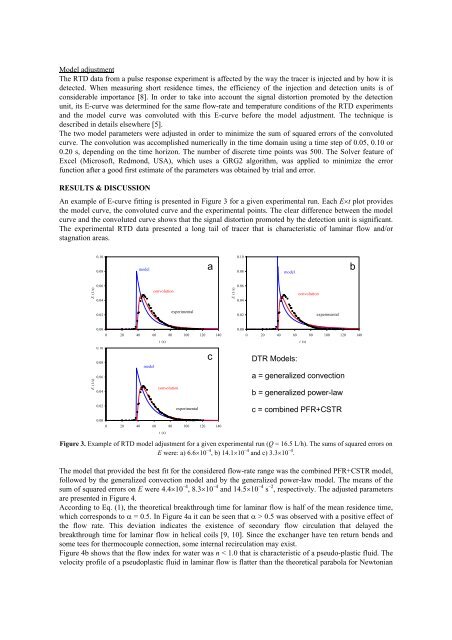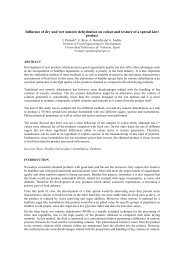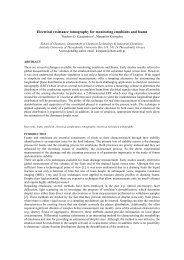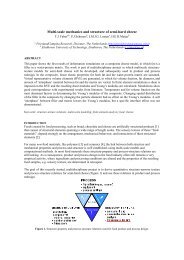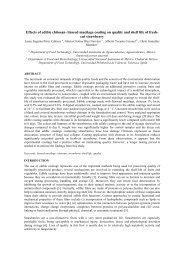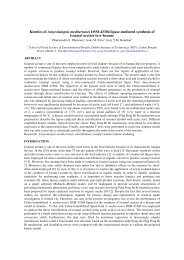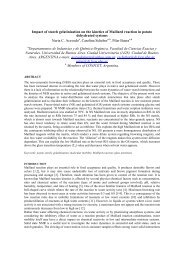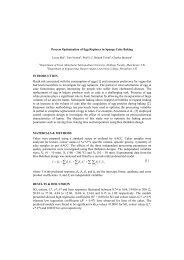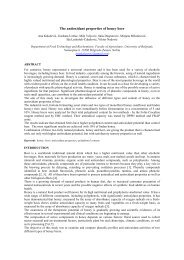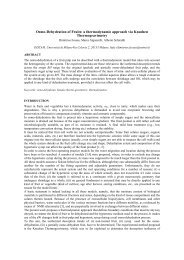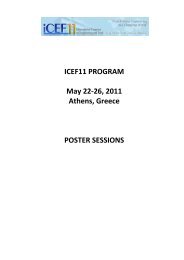Generalized convection and power-law models to represent ... - USP
Generalized convection and power-law models to represent ... - USP
Generalized convection and power-law models to represent ... - USP
Create successful ePaper yourself
Turn your PDF publications into a flip-book with our unique Google optimized e-Paper software.
Model adjustment<br />
The RTD data from a pulse response experiment is affected by the way the tracer is injected <strong>and</strong> by how it is<br />
detected. When measuring short residence times, the efficiency of the injection <strong>and</strong> detection units is of<br />
considerable importance [8]. In order <strong>to</strong> take in<strong>to</strong> account the signal dis<strong>to</strong>rtion promoted by the detection<br />
unit, its E-curve was determined for the same flow-rate <strong>and</strong> temperature conditions of the RTD experiments<br />
<strong>and</strong> the model curve was convoluted with this E-curve before the model adjustment. The technique is<br />
described in details elsewhere [5].<br />
The two model parameters were adjusted in order <strong>to</strong> minimize the sum of squared errors of the convoluted<br />
curve. The convolution was accomplished numerically in the time domain using a time step of 0.05, 0.10 or<br />
0.20 s, depending on the time horizon. The number of discrete time points was 500. The Solver feature of<br />
Excel (Microsoft, Redmond, USA), which uses a GRG2 algorithm, was applied <strong>to</strong> minimize the error<br />
function after a good first estimate of the parameters was obtained by trial <strong>and</strong> error.<br />
RESULTS & DISCUSSION<br />
An example of E-curve fitting is presented in Figure 3 for a given experimental run. Each Et plot provides<br />
the model curve, the convoluted curve <strong>and</strong> the experimental points. The clear difference between the model<br />
curve <strong>and</strong> the convoluted curve shows that the signal dis<strong>to</strong>rtion promoted by the detection unit is significant.<br />
The experimental RTD data presented a long tail of tracer that is characteristic of laminar flow <strong>and</strong>/or<br />
stagnation areas.<br />
0.10<br />
0.08<br />
model<br />
a<br />
0.10<br />
0.08<br />
model<br />
b<br />
E (1/s)<br />
0.06<br />
0.04<br />
convolution<br />
E (1/s)<br />
0.06<br />
0.04<br />
convolution<br />
0.02<br />
experimental<br />
0.02<br />
experimental<br />
E (1/s)<br />
0.00<br />
0 20 40 60 80 100 120 140<br />
t (s)<br />
0.10<br />
0.08<br />
model<br />
0.06<br />
convolution<br />
0.04<br />
c<br />
0.00<br />
0 20 40 60 80 100 120 140<br />
t (s)<br />
DTR Models:<br />
a = generalized <strong>convection</strong><br />
b = generalized <strong>power</strong>-<strong>law</strong><br />
0.02<br />
experimental<br />
c = combined PFR+CSTR<br />
0.00<br />
0 20 40 60 80 100 120 140<br />
t (s)<br />
Figure 3. Example of RTD model adjustment for a given experimental run (Q = 16.5 L/h). The sums of squared errors on<br />
E were: a) 6.610 –4 , b) 14.110 –4 <strong>and</strong> c) 3.310 –4 .<br />
The model that provided the best fit for the considered flow-rate range was the combined PFR+CSTR model,<br />
followed by the generalized <strong>convection</strong> model <strong>and</strong> by the generalized <strong>power</strong>-<strong>law</strong> model. The means of the<br />
sum of squared errors on E were 4.410 –4 , 8.310 –4 <strong>and</strong> 14.510 –4 s –2 , respectively. The adjusted parameters<br />
are presented in Figure 4.<br />
According <strong>to</strong> Eq. (1), the theoretical breakthrough time for laminar flow is half of the mean residence time,<br />
which corresponds <strong>to</strong> = 0.5. In Figure 4a it can be seen that > 0.5 was observed with a positive effect of<br />
the flow rate. This deviation indicates the existence of secondary flow circulation that delayed the<br />
breakthrough time for laminar flow in helical coils [9, 10]. Since the exchanger have ten return bends <strong>and</strong><br />
some tees for thermocouple connection, some internal recirculation may exist.<br />
Figure 4b shows that the flow index for water was n < 1.0 that is characteristic of a pseudo-plastic fluid. The<br />
velocity profile of a pseudoplastic fluid in laminar flow is flatter than the theoretical parabola for New<strong>to</strong>nian


